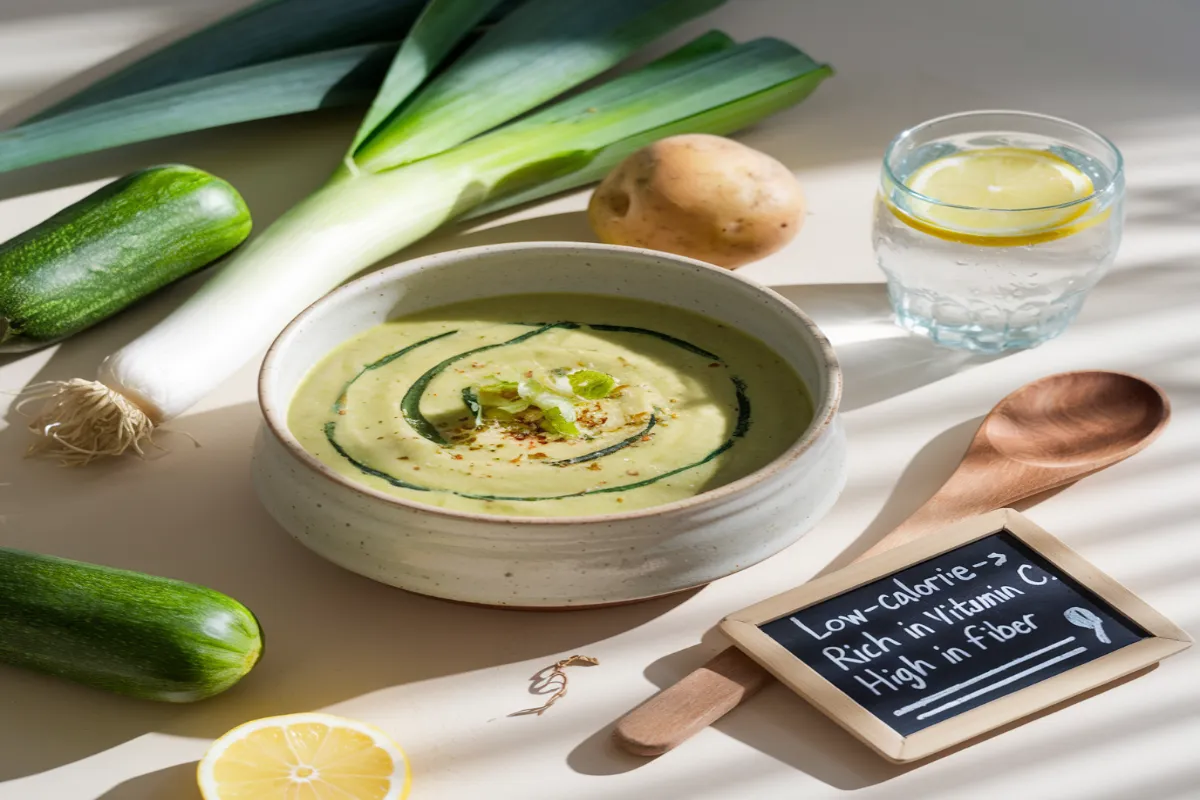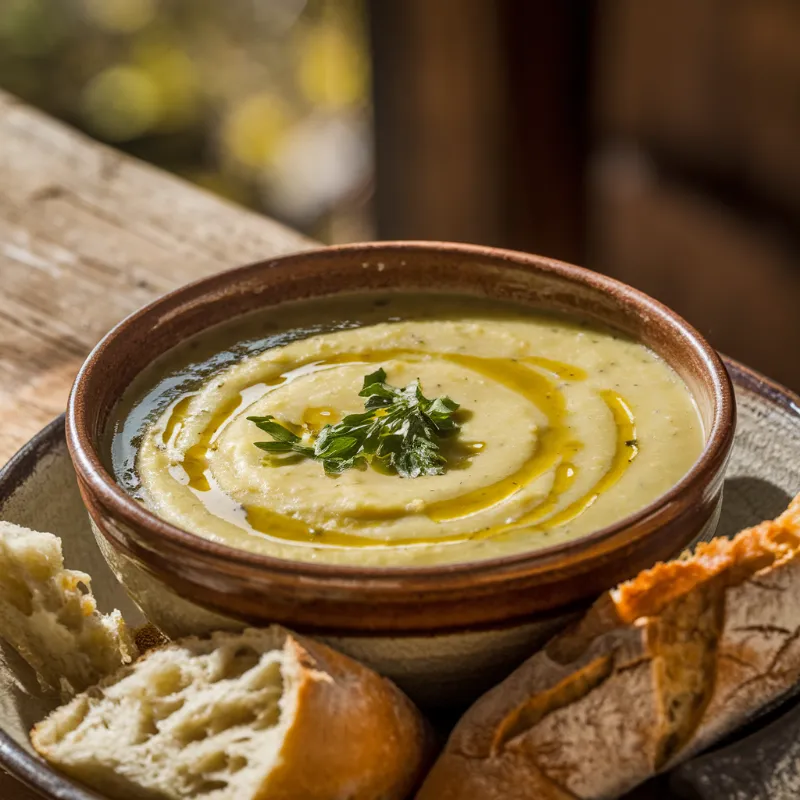There’s something truly magical about turning simple ingredients into a meal that warms the soul. I remember the first time I made this courgette soup for my family. They were sceptical at first—courgettes aren’t exactly the most exciting vegetable. But one spoonful was all it took to win them over. Now, it’s a firm favourite in our household.
What I love most about this recipe is how effortless it is. With just a handful of ingredients—like leeks, stock, and, of course, courgettes—you can whip up a nourishing lunch in no time. It’s perfect for those busy days when you need something quick yet satisfying.
Another bonus? This dish is incredibly versatile. Whether you’re dairy-free, vegan, or just looking to experiment, it’s easy to adapt. Plus, the creamy consistency can be adjusted to suit your taste. Trust me, once you try it, you’ll see why it’s earned a rating of nearly 5 stars from so many happy cooks.
Table of Contents
Ingredients and Pre-preparation Tips

The foundation of any great dish lies in the quality of its ingredients. Whether you’re a seasoned cook or just starting out, selecting the right components can elevate your meal from good to unforgettable. Let’s dive into some essential tips to ensure your next creation is a success.
Choosing Fresh Versus Frozen Vegetables
Fresh vegetables are always the first choice for their vibrant flavour and texture. When shopping, look for firm courgettes, crisp leeks, and potatoes without blemishes. However, frozen options like peas can be a lifesaver for busy cooks. They’re pre-chopped and ready to use, saving you valuable time.
Here’s a quick comparison to help you decide:
| Type | Pros | Cons |
|---|---|---|
| Fresh | Better flavour, higher nutrient content | Requires more prep time |
| Frozen | Convenient, longer shelf life | May lack some texture |
Essential Stock and Spice Selection
The stock you choose can make or break your dish. I highly recommend Marigold Bouillon Powder for its rich, savoury taste. It’s versatile and works beautifully in this recipe. For seasoning, don’t shy away from bold choices like a chopped red chilli or fresh herbs. They add depth and complexity to the final dish.
Here are a few pre-preparation tips to streamline your cooking process:
- Chop onions, garlic, and leeks finely for even cooking.
- Use a sharp knife to slice courgettes into uniform pieces.
- Keep your workspace organised to save time and reduce stress.
With these simple steps, even a modest kitchen set-up can produce professional results. Happy cooking!
Step-by-Step Cooking Method
Mastering this dish is easier than you think, even on the busiest of days. With a few straightforward techniques, you’ll have a delicious meal ready in no time. Let’s walk through the process together, ensuring every step is clear and stress-free.
Preparing the Vegetables and Aromatics
Start by finely chopping one onion and two garlic cloves. Heat a tablespoon of olive oil in a heavy-bottomed pan over medium heat. Add the onion and garlic, frying for about 5 minutes until softened and fragrant.
Next, slice 400g of courgettes and one leek into uniform pieces. Add these to the pan, stirring occasionally for another 5 minutes. This builds a rich flavour base for your dish.
Blending and Finishing Touches
Pour in 500ml of vegetable stock and bring the mixture to a gentle boil. Reduce the heat and let it simmer for 15-20 minutes, or until the vegetables are tender. For extra body, consider adding one diced potato during this stage.
Once cooked, use a hand blender to achieve a smooth, creamy consistency. This step is quick and ensures a professional-quality result. For a final touch, stir in a handful of grated cheese or a dairy-free alternative for added richness.
| Step | Time | Tip |
|---|---|---|
| Fry onions & garlic | 5 minutes | Use medium heat to avoid burning. |
| Add courgettes & leek | 5 minutes | Stir occasionally for even cooking. |
| Simmer with stock | 15-20 minutes | Add a potato for extra texture. |
| Blend & finish | 2-3 minutes | Use a hand blender for smoothness. |
This method is designed to be simple and effective, perfect for busy weeknights. With these steps, you’ll create a dish that’s both comforting and satisfying.
Mastering the courgette soup recipe
Perfecting a dish is all about the little details that make it shine. When it comes to this courgette soup recipe, achieving the ideal consistency and taste is easier than you might think. With a few simple adjustments, you can elevate this dish to a whole new level.
Consistency and Tasting Adjustments
Getting the right thickness is key. If you prefer a heartier texture, add an extra potato during cooking. For a thinner consistency, simply blend in a bit more stock. Taste as you go, adjusting the seasoning to balance the savoury and subtle sweet notes.
Here’s a quick guide to help you fine-tune your soup:
| Preference | Adjustment |
|---|---|
| Thicker | Add a diced potato or reduce stock slightly. |
| Thinner | Blend in extra stock or water. |
| Richer | Stir in grated cheese or a dairy-free alternative. |
Enhancing Flavour with Leek, Potato, and Chilli
Ingredients like leek and potato not only add body but also enrich the flavour profile. For a gentle kick, try adding a chopped red chilli during the cooking process. It’s a small addition that makes a big difference.
Here are my top tips for enhancing your soup:
- Use fresh leeks for a sweeter, more aromatic base.
- Add a potato for extra creaminess and texture.
- Introduce a chopped red chilli for a subtle heat.
With these adjustments, you’ll create a dish that’s consistently delicious and tailored to your taste. It’s no wonder this recipe has earned such a high rating!
Creative Variations and Pairings
One of the joys of cooking is the ability to adapt and personalise dishes to suit your taste and dietary needs. This courgette soup is no exception—it’s a versatile dish that can be tailored to fit various preferences. Whether you’re looking for dairy-free options or want to add a bit of spice, there’s a variation for everyone.
Dairy-Free and Vegan Alternatives
For those following a vegan or dairy-free diet, this recipe can easily be modified. Simply omit the cheese or replace it with a plant-based alternative like nutritional yeast or vegan cheese. These swaps maintain the creamy texture while keeping the dish entirely plant-based.
Here are some additional tips for vegan adaptations:
- Use vegetable stock instead of dairy-based options.
- Add a splash of coconut milk for extra richness.
- Top with toasted seeds or nuts for added crunch.
Adding a Spicy or Cheesy Twist
If you’re a fan of bold flavours, consider adding a chopped red chilli during cooking. It’s a simple way to introduce a gentle heat that complements the dish beautifully. For cheese lovers, a handful of mature cheddar or a dairy-free alternative can elevate the rating of this soup to new heights.
Here’s a quick guide to customising your soup:
| Variation | Ingredient | Effect |
|---|---|---|
| Spicy | Chopped red chilli | Adds a subtle kick |
| Cheesy | Mature cheddar | Enhances richness |
| Vegan | Nutritional yeast | Provides umami flavour |
Pair your soup with crusty bread, a jacket potato, or even a tuna melt for a complete meal. These creative tweaks not only refresh the dish but also make it appealing to a wide range of taste preferences. Don’t be afraid to experiment and share your variations on social media—it’s a great way to connect with other home cooks!
Nutritional Information & Health Benefits

Understanding the nutritional value of your meals can make a world of difference to your health. This dish is not only comforting but also packed with essential nutrients that support overall well-being. Let’s dive into what makes it a wholesome choice.
Caloric Breakdown and Vitamins
One serving of this dish contains approximately 200 calories, making it a light yet satisfying option. It’s rich in vitamin C, which boosts immunity, and potassium, which helps regulate blood pressure. These nutrients work together to keep your body functioning at its best.
Here’s a quick nutritional breakdown:
- Calories: Around 200 per serving.
- Vitamin C: 26% of the Daily Value (DV).
- Potassium: 10% of the DV.
- Fibre: 2 grams per serving, aiding digestion.
Incorporating a variety of green vegetables like courgettes helps you achieve the recommended 5-a-day. This not only supports a balanced diet but also ensures you’re getting a wide range of nutrients.
The fibre content in this dish is particularly beneficial. It promotes digestive health and helps maintain stable blood sugar levels. Plus, it keeps you feeling full for longer, making it a great choice for weight management.
Beyond its great taste, this dish is a nutritious addition to any meal plan. It’s a simple way to enjoy a healthy, vegetable-rich option that supports your overall health.

Courgette Soup recipe
Ingredients
Equipment
Method
- Sauté Aromatics: Heat olive oil in a heavy-bottomed pot over medium heat. Add the chopped onion and minced garlic. Sauté for about 5 minutes until softened and fragrant.
- Add Vegetables: Stir in the sliced leek, courgettes, and diced potato. Cook for another 5 minutes, stirring occasionally.
- Simmer with Stock: Pour in the vegetable stock and bring the mixture to a gentle simmer. Cook for 15-20 minutes until vegetables are tender.
- Blend Until Smooth: Let the mixture cool slightly. Transfer to a high-powered blender and blend until smooth and creamy. Adjust consistency with additional stock if needed.
- Season & Serve: Season with salt and pepper to taste. Serve warm with optional toppings.
Frequently Asked Questions
Can courgettes be made into soup?
Yes! Courgettes (zucchini) make a light, creamy soup that’s easy to prepare. They blend well with other ingredients like potatoes, sweet potatoes, or leeks. Their mild flavor makes them great for both simple soups and spicy variations!
What can I do with a surplus of courgettes?
If you have more courgettes than you know what to do with, try these ideas:
Make soup – Blended courgette soup is creamy and delicious.
Grill them – Slice and grill with olive oil and garlic.
Bake courgette bread or muffins – A great way to use them up!
Stir-fry – Toss them into pasta or rice dishes.
Freeze them – Slice or grate them for later use in soups or stews.
Stuff them – Hollow them out and fill with cheese, meat, or grains.
Courgettes are super versatile, so you’ll never waste them!
Is courgette soup healthy?
Yes! Courgette soup is:
Low in calories – Great for a light meal.
High in fiber – Good for digestion.
Packed with vitamins – Contains vitamin C, potassium, and antioxidants.
Hydrating – Courgettes have a high water content, which helps keep you hydrated.
For an extra healthy version, skip the cream and use vegetable broth instead!
How to make sweet potato and courgette soup?
This soup is creamy, comforting, and easy to make!
Ingredients:
1 large sweet potato, peeled and chopped
2 medium courgettes (zucchini), sliced
1 onion, diced
2 cloves garlic, minced
4 cups vegetable broth
1 tsp ground cumin (optional, for extra warmth)
Salt & pepper to taste
Olive oil
Instructions:
Heat olive oil in a pot and sauté the onion and garlic until soft.
Add the chopped sweet potato and courgettes. Season with salt, pepper, and cumin.
Pour in the broth and bring to a boil. Reduce heat and simmer for 20 minutes.
Blend until smooth and serve warm!
Pro tip: Garnish with roasted seeds or a swirl of coconut milk for extra flavor!
Do I need to peel courgettes for soup?
Nope! The skin is thin and full of nutrients, so leave it on. Just wash the courgettes well before slicing. Keeping the skin also gives your soup a nice green color!
How do you make courgette soup less bitter?
If your courgettes taste bitter, try these tips:
Use young, fresh courgettes – Older or overgrown ones can be bitter.
Remove the seeds – If they’re large, they may add bitterness.
Sauté before blending – Cooking them with onions and garlic helps soften the flavor.
Add a splash of cream or milk – This balances out any bitterness.
A pinch of sugar – If needed, a tiny amount can help neutralize bitterness.

